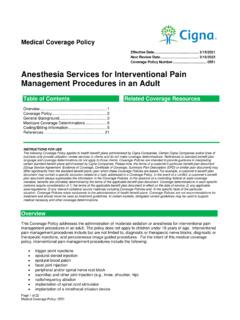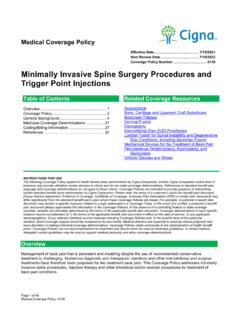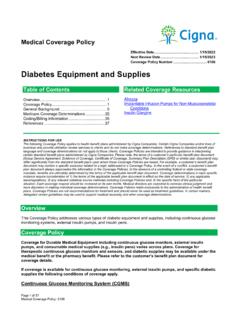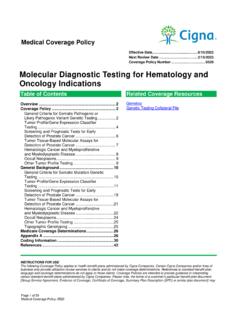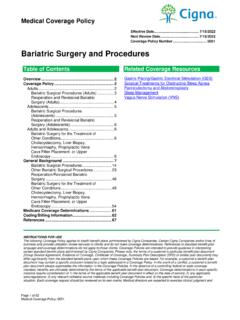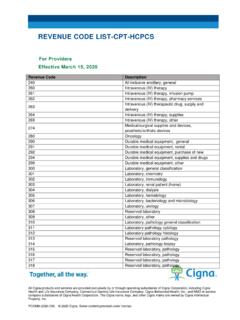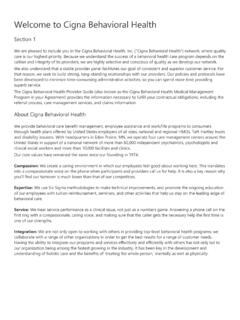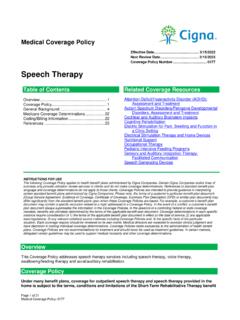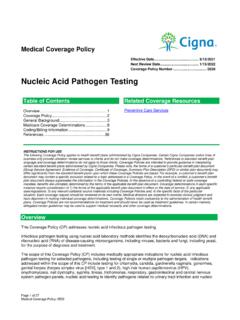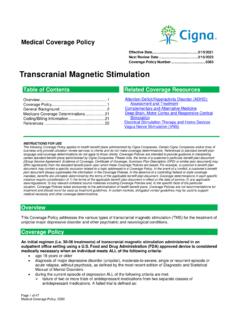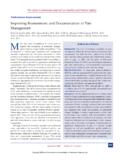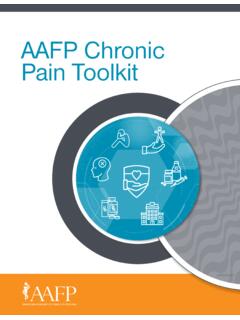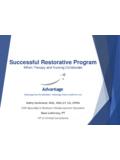Transcription of Cigna Medical Coverage Policy- Therapy Services Acupuncture
1 Acupuncture (CPG 024) Page 1 of 26 Cigna Medical Coverage Policy- Therapy Services Acupuncture Effective Date: 4/15/2021 Next Review Date: 4/15/2022 INSTRUCTIONS FOR USE Cigna / ASH Medical Coverage Policies are intended to provide guidance in interpreting certain standard benefit plans administered by Cigna Companies. Please note, the terms of a customer s particular benefit plan document may differ significantly from the standard benefit plans upon which these Cigna / ASH Medical Coverage Policies are based. In the event of a conflict, a customer s benefit plan document always supersedes the information in the Cigna / ASH Medical Coverage Policy. In the absence of a controlling federal or state Coverage mandate, benefits are ultimately determined by the terms of the applicable benefit plan document. Determinations in each specific instance may require consideration of: 1) the terms of the applicable benefit plan document in effect on the date of service 2) any applicable laws/regulations 3) any relevant collateral source materials including Cigna -ASH Medical Coverage Policies and 4) the specific facts of the particular situation Cigna / ASH Medical Coverage Policies relate exclusively to the administration of health benefit plans.
2 Cigna / ASH Medical Coverage Policies are not recommendations for treatment and should never be used as treatment guidelines. Some information in these Coverage Policies may not apply to all benefit plans administered by Cigna . Certain Cigna Companies and/or lines of business only provide utilization review Services to clients and do not make benefit determinations. References to standard benefit plan language and benefit determinations do not apply to those clients. Acupuncture is subject to the terms, conditions and limitations of the benefits as described in the applicable plan s schedule of copayments. Please refer to the applicable benefit plan document to determine benefit availability and the terms and conditions of Coverage . GUIDELINES Acupuncture Medically Necessary If Coverage for Acupuncture Services are available in the applicable benefit plan document, Acupuncture may be provided as treatment for ANY of the following conditions when ALL of the Medical necessity factors and ALL of the treatment planning /outcomes listed below are met: Tension-type Headache; Migraine Headache with or without Aura Musculoskeletal joint and soft tissue pain ( , hip, knee, spine) resulting in a functional deficit ( , inability to perform household chores, interference with job functions, loss of range of motion) Nausea Associated with Pregnancy (only when co-managed) Post-Surgical Nausea (only when co-managed) Acupuncture (CPG 024) Page 2 of 26 Nausea Associated with Chemotherapy; (only when co-managed) Medical Necessity Factors: Medically necessary Services must be delivered toward defined reasonable and evidence-based goals.
3 Medical necessity decisions must be based on patient presentation including diagnosis, severity, and documented clinical findings; Continuation of treatment is contingent upon progression towards defined treatment goals and evidenced by specific significant objective functional improvements ( , outcome assessment scales, range of motion) Certain conditions require that the patient is being co-managed by a Medical physician in order to be considered medically necessary; Medically necessary Services including monitoring of outcomes and progress with a change in treatment or withdrawal of treatment if the patient is not improving or is regressing. Treatment Planning/Outcome Factors: An individualized treatment plan ( , frequency and duration of service) is appropriately correlated with clinical findings and clinical evidence; Treatment is expected to result in significant therapeutic improvement over a clearly defined period of time; Therapeutic goals are functionally oriented, realistic, measurable, and evidence-based; Proposed date of release/discharge from treatment is estimated; Functional Outcome Measures (FOM)1, when used, demonstrates Minimal Clinically Important Difference (MCID)1 from baseline results through periodic re-assessments; documentation substantiates practitioner s diagnosis and treatment plan; Demonstration of progression toward active home/self-care and discharge, and; Maximum therapeutic benefit has not been reached.
4 Not Medically Necessary Acupuncture is considered not medically necessary for either of the following indications: Treatment intended to improve or maintain general physical condition Maintenance Acupuncture Services , when significant therapeutic improvement is not expected Experimental, Investigational, Unproven Acupuncture for any other indication, including infertility and recurrent pregnancy loss, is considered experimental, investigational or unproven. Acupuncture POINT INJECTION Therapy Acupuncture point injection Therapy is considered experimental, investigational or unproven. DESCRIPTION AND BACKGROUND Acupuncture is a form of complementary and alternative medicine that has been widely practiced for many centuries. It involves the stimulation of specific anatomical locations on the skin through the penetration of fine needles, with the goal of relieving pain or treating disease. Stimulation can be accomplished manually ( , by a twisting motion of the hand) or through such methods as electrical stimulation ( , electroacupuncture).
5 The practice of traditional Acupuncture is predicated upon several fundamental underlying principles. It is predicated upon the existence of a series of meridians that course through the body along which are located discrete points that correspond to specific organs and/or have particular clinical significance. A vital energy, chi, flows through 1 Not all outcome measures have MCID s determined and supported in the literature. Actual significance of these findings requires correlation with the overall clinical presentation, including updated subjective and objective examination findings Acupuncture (CPG 024) Page 3 of 26 the meridians and the Acupuncture points and regulating bodily functions. It is the disruption of this flow of energy that therapeutic Acupuncture is said to address. Acupuncture typically utilizes unique diagnostic procedures to evaluate the meridian/chi system. This includes an evaluation of the patient s chief complaint and related health status through standardized diagnostic interviewing and examination techniques.
6 Interviews are based on the traditional Ten Questions and examinations include, but are not limited to, evaluation of meridians, points, general vitality and behavior, the radial pulses and the tongue. Based upon the patient s complaint and the findings of these diagnostic procedures, individualized treatment regimens are developed that specify treatment variables such as the Acupuncture points to be utilized, needle placement, and type of needle stimulation. A majority of states provide licensure or registration for Acupuncture practitioners, although the scope of practice allowed under state requirements varies. Depending upon the jurisdiction, those licensed to administer Acupuncture may include licensed acupuncturists (LAc), Medical /osteopathic physicians (MD/DO), chiropractors (DC), naturopaths (ND), oriental medicine doctors (OMD), podiatrists (DPM), dentists (DDS/DMD), nurse practitioners (NP), physician assistants (PA), as well as other designated health care providers.
7 Depending upon the practitioner s training, different systems of Acupuncture diagnosis and treatment may be used. The National Institutes of Health (NIH) Consensus Panel and the Food and Drug Administration (FDA) consider Acupuncture safe when performed by qualified practitioners using sterile needles. The FDA requires that sterile, nontoxic needles be used and that they be labeled for single use by qualified practitioners. Acupuncture appears to be a relatively safe treatment with rare serious adverse side effects when performed by qualified practitioners who consistently adhere to the recommendations of the FDA regarding the use of sterile needles. Depending on the pain condition being treated, a course of Acupuncture may last several weeks. Although there is no consensus in the scientific literature regarding the optimal number of Acupuncture treatments to administer or the duration of treatment for any condition, in general, there should be a reasonable expectation for clinical improvement.
8 If no improvement is documented after an initial trial of two-four weeks treatment, an alternative treatment plan should be considered. If lack of clinical improvement continues following subsequent treatments re-evaluation by the referring provider may be indicated. If measurable objective improvement is made, then progress towards identified goals should be clearly documented and the treatment plan updated accordingly. The necessity of continued care beyond a therapeutic trial is dependent upon objective evidence of improvement ( , functional gain). Multiple different biological mechanisms have been proposed and studied to explain Acupuncture . All of these proposed mechanisms are centrally mediated and not merely local physiologic responses. Most commonly it is thought that the stimulation of the Acupuncture needle triggers the release of endogenous opioids (endorphins). This effect seems the most pronounced in electro- Acupuncture .
9 Another possible mechanism is through the diffuse noxious inhibitory control pathway (DNIC). According to DNIC, a noxious stimulus applied to any region of the body can induce immediate suppression of pain transmission in neurons of the trigeminal caudalis and/or the spinal dorsal horn. Another theory proposes that the descending serotoninergic inhibitory pathway is key to Acupuncture analgesia. In addition, there is some preliminary evidence that Acupuncture may have effects on the inflammatory response mediated through the autonomic nervous system. Current available evidence indicates that insertion of Acupuncture needles has an effect above waiting list controls but there is limited available evidence to define whether exact needle placement on established Traditional Acupuncture points is necessary to produce a result. None of the mechanisms of action postulated for Acupuncture affects are sufficiently well understood to have established a dispositive answer to describe the exact physiological mechanism by which Acupuncture produces its analgesic and antiemetic effects.
10 Acupuncture Point Injection Therapy Acupuncture point injection Therapy is a procedure where pharmaceuticals and natural biologic products such as vitamins, herbal extracts and other homeopathics, are injected into the body at Acupuncture points to prevent or treat disease. One solution in particular, isotonic saline, when injected theoretically allows activation of the Acupuncture point for a longer period of time enhancing the therapeutic effect. Acupuncture (CPG 024) Page 4 of 26 documentation GUIDELINES Evaluation An initial evaluation service is essential to determine whether any Acupuncture Services are medically necessary, to gather baseline data, establish a treatment plan, and develop goals based on the data.. The initial evaluation service must include: An appropriate level of clinical history, examination, and Medical decision-making relevant and appropriate to the individual s complaint(s) and presentation; Subjective historical evaluation based on standardize method such as the 10 questions; Specific standardized and non-standardized tests, assessments, and tools; Interpretation and synthesis of all relevant clinical findings derived from history and physical examination for the purpose of clinical decision-making; Subjective and objective measurable, description of functional status using comparable and consistent methods; Summary of clinical reasoning and consideration of contextual factors with recommendations; The establishment of a working diagnosis; Plan of care with specific treatment techniques or activities to be used in treatment sessions that should be updated as the individual's condition changes.
